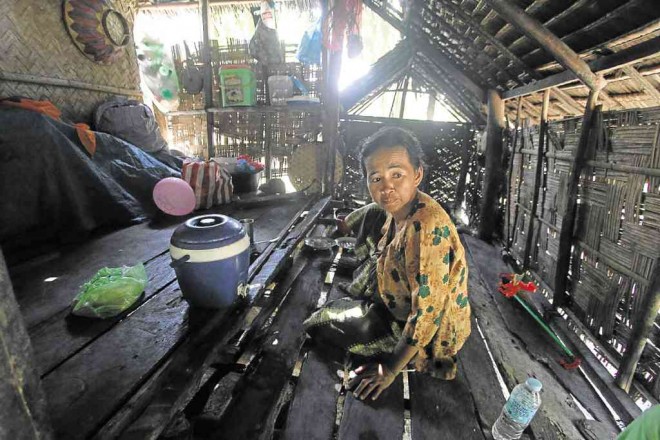
Bai Puti Kusain, 37, mother of 10, inside her hut in the village of Tukalanipao in Mamasapano town. She owns and tills the cornfield where 44 police commandos and a civilian were killed in the mission to get international terrorist Marwan. KARLOS MANLUPIG/INQUIRER MINDANAO
MAMASAPANO, Maguindanao—Unlike the rooms in Congress where the din of voices competing for attention drown the sound of reason, the town of Mamasapano in Maguindanao province is almost deathly quiet.
On Thursday, people peeked through their windows while others cautiously approached as a convoy of vehicles carrying members of foreign and local nongovernment organizations arrived.
Wearing a purple hijab, 37-year-old farmer Bai Puti Kusain sat quietly as women community workers explained to her the rights she has as an internally displaced person.
Kusain, a single mother of 10, owns and tills the cornfield where members of the 55th Special Action Company of the police Special Action Force were pinned down by Moro gunmen on Jan. 25.
She vividly remembers the day. The sun was rising and she was preparing for work in the fields when gunfire erupted.
“We are really clueless about what happened,” she said. “We just heard the gunshots on Sunday dawn and now our lives are in disarray,” Kusain said, talking in her native Maguindanaon.
It’s been three weeks since more than 300 SAF commandos entered the town in a mission that now bears the infamy of being the deadliest ever by a police force that succeeded in getting its target, international terrorist Marwan, but failed miserably in protecting 44 commandos who were killed in the botched exit plan.
While senators and congressmen, whom residents are not even aware existed, are squabbling about the bloodshed, families are apprehensive about their future.
“I cannot even go back to our cornfield because we are afraid that explosives and unexploded munitions were left there and might kill us,” Kusain said.
As a mother who single-handedly raises 10 children, she said every kernel of corn meant food on their table and “baon” for her children.
“It is hard to be dependent on a small farm if you are a single mother to ten kids but now life is even harsher,” Kusain said.
After blood was spilt on her cornfield, Kusain is now afraid that no one would again lend her money for farm inputs for the next cropping.
To make it more painful, her cousin, Badrudin Langalan, was found tied and dead in the cornfield near the bodies of the SAF commandos.
Langalan’s wife, Sarah, said her husband was not involved in the fighting and was only on his way to charge his mobile phone in the village center when the commandos allegedly seized and killed him.
Sarah was reluctant to speak more but her face and eyes clearly express her pain.
At her parents’ house, where she currently stays with her daughters, Sarah said she knows opportunities are few for people like her who had finished only elementary school.
Wiping perspiration off the face of her daughters, Sarah said her eldest got her father’s eyes and nose.
But the child, Sarah said, is hurting. “She is mad. She does not like soldiers,” Sarah said explaining that her child is too young to distinguish SAF commandos from soldiers.
Sarah also admitted that she is angry but does not know whom or where to direct her anger.
Asked if she wants to ask help from the government, Sarah said she is not expecting any but finds it unfair for all the media mileage, financial help and even housing packages are given to the SAF commandos, which residents see as intruders in their small town.
Days after the bloodshed, the Department of Social Welfare and Development opened a bank account to receive cash donations for families of the SAF commandos who were killed in action.
There was no such effort for the families of civilians who were killed even if they are barely surviving below the poverty line.
The local government gave her P25,000 but Sarah said she was confused and tried to reject it because she thought it was payment for her husband’s life. Justice is what they need, Sarah said.
In interviews with residents of members of the fact-finding mission, it is evident that many of the residents were hesitant to speak.
In hushed tones, many residents commented that numerous groups and journalists came to the area and asked the same questions over and over again but attention shifts to bickering politicians.
“Sharing our stories again and again is tiring and very depressing. But after we gave our narratives nothing happened. There was no public furor to help us regain normalcy. There was no uproar to bring attention to the MILF fighters and civilians who also died,” said a displaced resident.
Ghadzali Jaafar, vice chair for political affairs of the MILF, agreed saying that several residents and Moro leaders in the town feel they are not citizens of the country and are being excluded as a result of politicians’ grandstanding.
UK-based Oxfam commented that it was important for the investigation to progress but special attention be given to the communities and residents hurt by the conflict.
At least 6,620 residents, mostly women and children from six villages, were directly affected by the Jan. 25 bloodshed. At least 13 schools suspended classes affecting hundreds of students.
Lyca Sarenas, of the Oxfam Mindanao Programme, said like in other conflicts in the country, women and children are usually forgotten, exposing them to risks that include extreme poverty, hunger and diseases.
Amid the confusion and high emotions, especially in social media, Sarenas said the bloodshed and its effect on women should convince more people that peace is the only sane solution.
“The recent tragedy should compel us to be more unyielding in pursuing the path towards just and lasting peace,” Sarenas said. Karlos Manlupig, Inquirer Mindanao